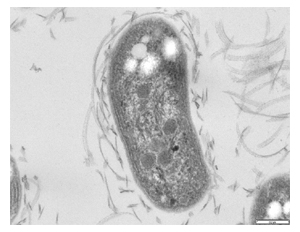Nitrobacter winogradskyi Nb-255 and other nitrite-oxidizing bacteria (NOB), carry out a key step in the nitrogen cycle by converting nitrite, the end product of ammonia oxidation, into nitrate. Nitrification, which is initiated by the ammonia-oxidizing bacteria (AOB), is thereby completed by the action of the NOB. N. winogradskyi Nb-255 is metabolically versatile. It can grow as a chemolithoautotroph by deriving energy from nitrite oxidation and fixing carbon dioxide as its source of carbon. In the absence of nitrite, N. winogradskyi Nb-255 can grow as a chemoorganoheterotroph and utilize organic compounds as sole carbon and energy sources (Bock et al., 1986; Bock et al., 1991) . When provided with a combination of nitrite and organic compounds, N. winogradskyi Nb-255 can utilize both substances simultaneously in mixotrophic growth (Bock et al., 1986; Bock et al., 1991). Finally, growth of N. winogradskyi Nb-255 can occur in aerobic as well as anoxic environments, and in the latter case is supported by the use of nitrate as its terminal electron acceptor (Bock et al., 1988). Perhaps reflective of its diverse metabolic capabilities, N. winogradskyi is widely distributed in the environment, and strain Nb-255 has served as the model organism for many of the classical studies on NOB physiology (Bock et al., 1986; Bock et al., 1991). Nitrification has broad-reaching environmental consequences, and understanding the interactions occurring between AOB and NOB that affect this process could facilitate development of improved strategies for nitrogen management. The genome sequence of N. winogradskyi , along with that of the AOB and other NOB, will be essential tools needed to elucidate these interactions (Starkenburg et al., 2006). The culture originally isolated and described by Winogradsky (1892) as " Nitrobacter " was not preserved (Watson, 1971). Thus, N. winogradskyi Nb-255 is considered a neotype culture for this species and is cataloged in the American Type Culture Collection (ATCC) as strain ATCC 25391. Synonyms for N. winogradskyi include Nitrobacter agilis (Watson, 1971), Bacillus nitrobakter and bacterium Nitrobacter. The cells of N. winogradskyi Nb-255 are pleomorphic short rods that divide by polar swelling. The transmission electron micrograph (TEM) above of N. winogradskyi Nb-255 illustrates unique morphological and structural features of the organism including an asymmetric multilamellar membrane system, carboxysomes, and intracellular inclusion bodies. References Bock, E., Koops, H.P., Harms, H. 1986. Cell Biology of Nitrifiers, p. 17-38. In J. I. Prosser (ed.), Nitrification, vol. 20. IRL, Oxford ; Washington, D.C. Bock, E., P. A. Wilderer, and A. Freitag. 1988. Growth of Nitrobacter in the absence of dissolved oxygen. Wat. Res. 22: 245-250. Bock, E., H.-P. Koops, H. Harms, and B. Ahlers. 1991. The biochemistry of nitrifying organisms, p. 171-200. In J. M. Shively and L. L. Barton (ed.), Variations in autotrophic life. Academic Press, San Diego, CA. Starkenburg, S.R., P.S.G. Chain, L.A. Sayavedra-Soto, L. Hauser, M.L. Land, F.W. Larimer, S.A. Malfatti, M.G. Klotz, P.J. Bottomley, D.J. Arp, and W.J. Hickey . 2006. The genome sequence of the chemolithoautotrophic nitrite-oxidizing bacterium Nitrobacter winogradskyi Nb-255. Appl. Environ. Microbiol. 72:2050-2063. Watson, S.W. 1971. Taxonomic considerations of the family Nitrobacteraceae Buchanan. Int. J. Syst. 21:254-270. Winogradsky, S. 1892. Contributions à la morpologie des organisms de la nitrification. Arch. Sci. Biol. St. Petersb. 1:86-137.
|
||
|
||
Nitrobacter winogradskyi Nb-255

